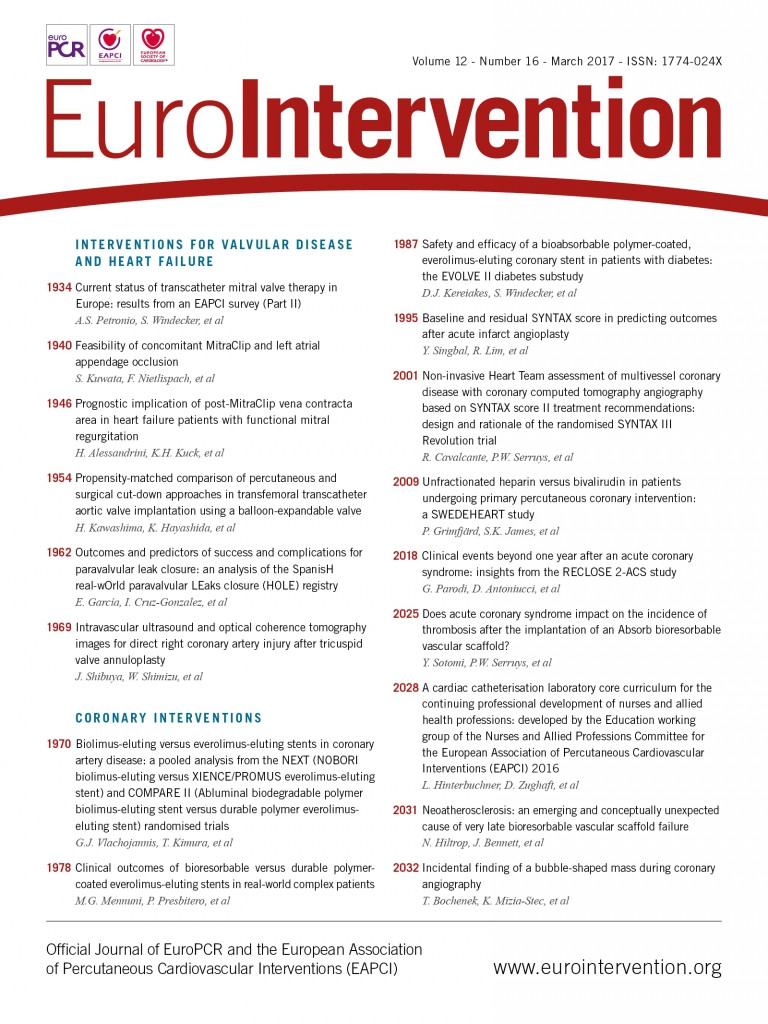
Exactly 10 years ago, the Rotterdam group reported on the first true percutaneous implantation of the 18 Fr CoreValve Revalving System (Medtronic, Minneapolis, MN, USA) by the combined use of ultrasound-guided vascular access, Prostar® XL (Abbott Vascular, Santa Clara, CA, USA), and TandemHeart™ (Cardiac Assist Inc., Pittsburgh, PA, USA) support1. Possibly overlooked, this transformative moment was the embodiment of the much-heralded movement of TAVI towards a true “PCI-like” intervention. As a result of the downsizing of delivery catheters and the implementation of best practice guidelines, a percutaneous transfemoral approach is now used in more than 90% of patients undergoing TAVI at most centres. Of note, TAVI by the transfemoral access has shown superior clinical outcomes compared with surgical aortic valve replacement during midterm follow-up2. In addition, many centres are routinely using local anaesthesia and reserve general anaesthesia for possibly complicated procedures. Having said that, a handful of experienced centres are still performing transfemoral TAVI using general anaesthesia and surgical cut-down.
Observational studies may be biased in their ability to assess treatment effects because treatment allocation is not randomised. Propensity score matching has become a popular matching method for causal analysis in observational studies. Propensity score matching provides a method to “adjust” for differences in characteristics between patients undergoing either experimental or control interventions. In essence, the process of propensity score matching attempts to model the “hidden” randomised trial within an observational data set. Suffice to say, propensity score matching can be an attractive method either to inform the design of future randomised controlled trials, or to provide evidence-based medicine when randomised controlled trials are unlikely to happen due, for example, to economic or ethical barriers.
In the current issue of the journal, Kawashima et al apply propensity score matching to 586 patients enrolled in a prospective observational Japanese multicentre transcatheter aortic valve implantation (TAVI) registry using the Edwards SAPIEN™ XT prosthesis (Edwards Lifesciences, Irvine, CA, USA) to compare outcomes between those patients undergoing transfemoral percutaneous (n=305) versus surgical cut-down (n=281) TAVI3. After propensity score matching, 332 patients (57% of the total cohort) were available for study, 166 percutaneous and 166 surgical cut-down. There is a dearth of literature on this topic and the current study appropriately fills a knowledge gap.
The authors note that a “percutaneous or surgical cut-down approach was chosen by each operator according to vessel calcification, tortuosity, and vessel size”. Prior to propensity matching, however, the percutaneous or surgical cut-down groups did not differ with respect to femoral vessel size and calcification severity. Variables influencing either treatment allocation and/or clinical outcome should be included in the propensity score model. Omitting important variables in the propensity score model can aggravate the problem of bias in estimating treatment effects. Given the multicentre nature of the current study, the possibility exists that variables associated with treatment allocation varied by centre. In order to mitigate these potential biases, it may have been preferable to derive propensity scores that incorporate separate multivariable models for each centre. Nonetheless, the allocation of 281 of 586 patients to a surgical cut-down femoral approach is not in keeping with current clinical practice standards in North America or Europe.
The results of the current study suggest that the percutaneous transfemoral TAVI approach is associated with shorter procedural times (30 minutes less), lower rates of major vascular complications (15% vs. 27%), bleeding (43% vs. 22%), transfusion requirements (21% vs. 38%), access-site bleeding (16% vs. 30%) and shorter length of hospital stay (8 vs. 12 days) than a surgical cut-down approach. A similar trend was reported by Nakamura et al where minor bleeds, use of packed red blood cells (PRBC) <4 units, wound infections, and median length of hospital stay were lower with a percutaneous than with a surgical cut-down approach; stenosis and dissections, however, were greater using the percutaneous approach4. According to the Brazil TAVI registry, the combined endpoint of mortality, life-threatening bleeds, and major vascular complications at one-year follow-up did not differ between a transfemoral percutaneous and a surgical cut-down approach5. The current study and previous reports confirm the present preference for a percutaneous transfemoral approach.
The recent introduction of TAVI in Asia provides a unique opportunity to revisit “older topics” (e.g., transfemoral percutaneous vs. surgical cut-down), while also projecting us “back to the future” on such topics as TAVI for bicuspid aortic valves. We look forward to continued collaboration and learning more from our Asian colleagues and friends.
Conflict of interest statement
N. Piazza is a consultant for Medtronic, HighLife, Boston Scientific and MicroPort. S. Windecker has received research grants to the institution from Abbott, Biotronik, Boston Scientific, Medtronic, Edwards Lifesciences and St. Jude.

